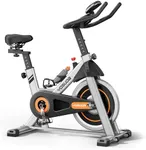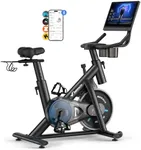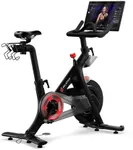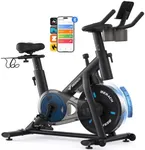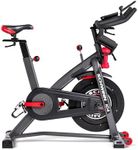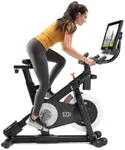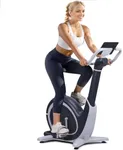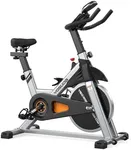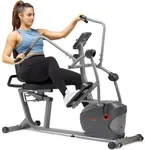Buying Guide for the Best Spinning Bikes
Choosing the right spinning bike can greatly enhance your indoor cycling experience. It's important to consider various factors to ensure that the bike you select meets your fitness goals, comfort, and space requirements. Here are some key specifications to look at when picking a spinning bike and how to navigate through them to find the best fit for you.Flywheel WeightThe flywheel is the heavy wheel at the front of the bike that creates resistance as you pedal. A heavier flywheel (typically 30-50 lbs) provides a smoother and more stable ride, mimicking the feel of riding a real bike. Lighter flywheels (under 30 lbs) may be easier to start and stop but can feel less stable. If you are a beginner or have joint issues, a lighter flywheel might be more suitable. For more experienced riders looking for a challenging workout, a heavier flywheel is recommended.
Resistance TypeResistance on spinning bikes can be magnetic or friction-based. Magnetic resistance is quieter, requires less maintenance, and offers a smoother ride. Friction resistance, on the other hand, is usually cheaper and can provide a more intense workout. If you prefer a quieter and low-maintenance bike, go for magnetic resistance. If you are looking for a more affordable option and don't mind a bit of noise, friction resistance could be the way to go.
AdjustabilityAdjustability refers to how much you can customize the bike to fit your body. This includes adjustable seat height, handlebar height, and seat position (forward/backward). Proper adjustability ensures a comfortable and ergonomic riding position, reducing the risk of injury. If multiple people will be using the bike, or if you have specific comfort needs, look for a bike with a high level of adjustability.
Drive SystemThe drive system connects the pedals to the flywheel and can be either chain-driven or belt-driven. Chain-driven systems are similar to outdoor bikes and can be noisier and require more maintenance. Belt-driven systems are quieter, smoother, and require less maintenance. If you prefer a quieter ride and less upkeep, a belt-driven system is ideal. If you want a more authentic cycling feel and don't mind the noise, a chain-driven system might be better.
Console FeaturesMany spinning bikes come with a console that displays workout metrics such as time, distance, speed, calories burned, and heart rate. Some advanced models offer connectivity to apps and online classes. If tracking your progress and having interactive workouts is important to you, look for a bike with a comprehensive console. If you prefer a simpler setup, a basic console or no console at all might suffice.
Weight CapacityWeight capacity indicates the maximum user weight the bike can support. This is important for safety and durability. Most spinning bikes have a weight capacity ranging from 250 to 350 lbs. Choose a bike that can comfortably support your weight, and consider a higher capacity if multiple users with varying weights will be using the bike.
Footprint and PortabilityThe footprint is the amount of space the bike occupies, and portability refers to how easy it is to move the bike. If you have limited space, look for a bike with a smaller footprint. Many bikes come with transport wheels, making it easier to move them around. Consider your available space and whether you need to move the bike frequently when making your choice.
